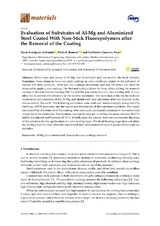Evaluation of Substrates of Al-Mg and Aluminized Steel Coated With Non-Stick Fluoropolymers after the Removal of the Coating
Autor
Rodríguez-Alabanda, O.
Romero, Pablo E.
Guerrero-Vaca, G.
Editor
MDPIFecha
2018Materia
Al-MgAluminized steel
Fluoropolymers
Coatings
Removal
METS:
Mostrar el registro METSPREMIS:
Mostrar el registro PREMISMetadatos
Mostrar el registro completo del ítemResumen
Many trays and pieces of Al-Mg and aluminized steel are used in the food industry. Sometimes these elements have non-stick coatings to solve problems related to the adhesion of masses and food products. With use, the coatings deteriorate and lose efficiency and must be removed to apply a new coating. The thermal cycles suffered by these alloys during the removal process of the deteriorated coating (500 _C) and the polymerization of a new coating (400 _C) can affect the durability and efficiency of the metallic substrates. The evolution of the mechanical and microstructural properties of the Al-Mg and aluminized steel substrates after two thermal cycles was studied in this work. The following parameters were analyzed: tensile strength, elongation (%), hardness, ASTM grain size, and the nature and distribution of the constituent particles. The report concluded that the removal of the coating, after each cycle, produced a decrease in the mechanical properties of the substrates. The hardness and tensile strength in Al-Mg decreases between 20–27% and in aluminized steel between 10–11%. In both cases, the process does not compromise the reuse of the substrate for the application of a new coating layer. The final blasting stage does not affect the Al-Mg alloys but may affect the aluminized steel Al-Si protective layer if special precautions are not taken.

